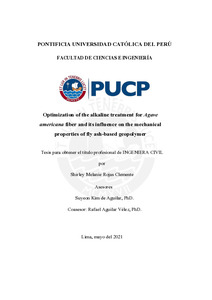Optimization of the alkaline treatment for Agave americana fiber and its influence on the mechanical properties of fly ash-based geopolymer
Abstract
Geopolymers are good alternatives for replacing ordinary Portland cement (OPC) due to
their comparable properties and feasibility to be obtained from industrial by-products. As
OPC, geopolymers have superior compressive strength but a brittle behavior that the
addition of fibers can improve. When the first macrocrack appears, fibers develop bridging
mechanisms to allow the proper distribution of loads, so the composite can enable multiple
cracks and enhance its ductility. At present, a wide range of materials can be used to
reinforce cementitious matrices, from synthetics such as steel, glass, carbon, and
polypropylene to natural fibers such as cotton, sweet sorghum, oil palm, coir, jute, sisal,
flax, bamboo, etc. Natural fibers are among the most accepted resources to reinforce
composites because they are biodegradable, renewable and generally, have a less
environmental impact than their synthetic counterparts. They have low density and specific
mechanical properties comparable to fibers made of glass, making them materials with a
good performance-price ratio. However, their high variability of properties and hydrophilic
behavior can create issues when reinforcing a matrix. Chemical treatments are used to clean
chemical compounds that do not contribute to the fiber strength and favor moisture
absorption. After treatment, the fiber surface increases its roughness which enhances the
interlocking within the composite. This thesis investigates the mechanical properties of
Agave americana fibers obtained by beating and boiling the leaves. The fibers were
subjected at 1%, 5%, and 20% NaOH concentrations over 0.5 hr, 1 hr, and 3 hr and tested to
determine the tensile strength. The surfaces were also analyzed by scanning electron
microscopy (SEM). After treatment, most of the fibers enhanced the tensile strength and
strain and 1% NaOH concentration over 1 hr was chosen as the optimum condition. Then,
fibers were treated at the optimum condition and added to the geopolymer mixture at
different doses: 0.5%, 0.75%, and 1% by weight of fly ash. The geopolymers were tested at
compressive, flexural, and splitting tensile loads at 7 days of age. The compressive strength
increased by 12% at 0.75 (wt.%) and the modulus of elasticity in compression, 13% at 1%
(wt.%). Also, the tensile strength increased by 36% at 1 (wt.%). However, the flexural
strength decreased probably due to the fiber length. Still, further studies are needed to
understand the influence of the fiber length on the mechanical properties of geopolymers.
Finally, the SEM analysis was conducted to identify the fiber failure modes.
Temas
Compuestos orgánicos
Polímeros
Materiales de construcción
Cemento impregnado de polímeros
Fibras vegetales
Polímeros
Materiales de construcción
Cemento impregnado de polímeros
Fibras vegetales
Para optar el título de
Ingeniero Civil
Collections
The following license files are associated with this item:






